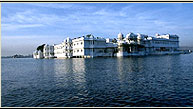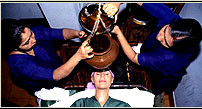-| Kondivite Caves | -
Location: District Bombay Suburban - Lat 19º 9' N, Long 72º
53' E

Kondivite caves are situated 6 kms. east of Andheri railway station and 13 kms.
south of Kanheri caves in Bombay. There are 18 caves in total and arranged in
two groups -15 on the east and 3 on the west side of the summit of a hill of
no great height. This small series is partially remarkable for the plain but
interesting chaitya griha. The plan of a chaitya griha consisting of long astylar
hall with a circular sanctuary at the back end. The entrance to the hall is
flat but that of the sanctuary is domical without any ribs. The outer sanctuary
is curved imitation of the thatched hut with a domical roof. These evidences
prove that in the preceding century, the building and houses were made of wooden
structural members, which later on transformed into the rock cut - more durable
and lasting than the perishable wood.
The monolithic stupa inside sanctuary has a conspicuously high drum crowned
by a three terraced railing with a basement and a coping. On the right wall
of the hall, Several reliefs of Lord Buddha were added in the 5th and 6th century
AD. All the figures, with the exception of one, are in sitting position and
the longest composition depict the master in the preaching attitude. In this
panel, Lord Buddha is attended by Padampani and another Bodhisattva.
Among the monasteries, cave 13, a work of about the 6th century AD is the only
one which has a typical plan of fully developed monastery. The door frame of
the shrine of this monastery is decorated with the motive of a pillared pavilion.
The cave 4 consists of a pillar benched veranda and spacious benched astylar
hall with a pillared corridor excavated in the side and the back walls. Each
side of the corridor gave access to a set of three cells in row approached by
a flight of steps from a moulded platform in front. Cave 2 presents a veranda
and astyar specious oblong hall. Beside these caves, there are scanty remains
of structural stupa, not only on the crust of the hills, but also on the terrace
in front of the eastern group of cells. Further, there are several monolithic
votive stupas all portable.




